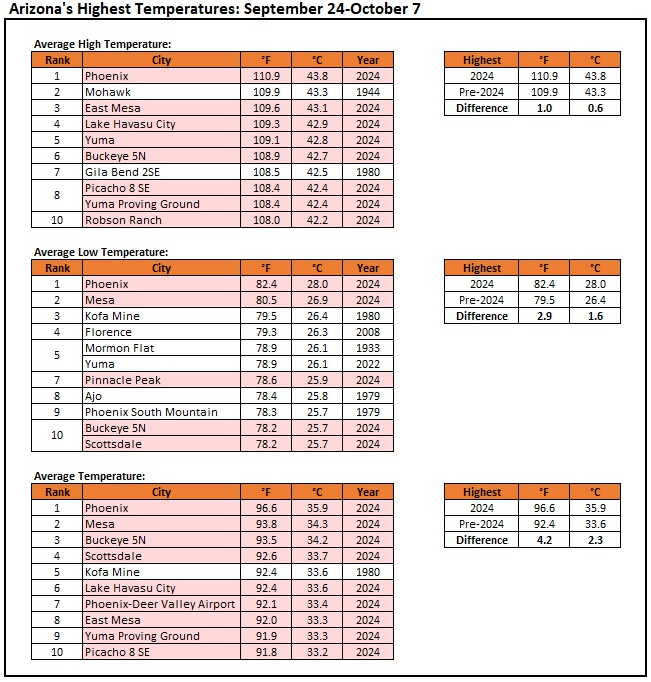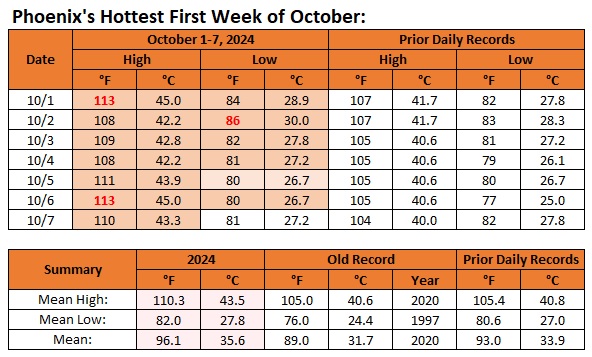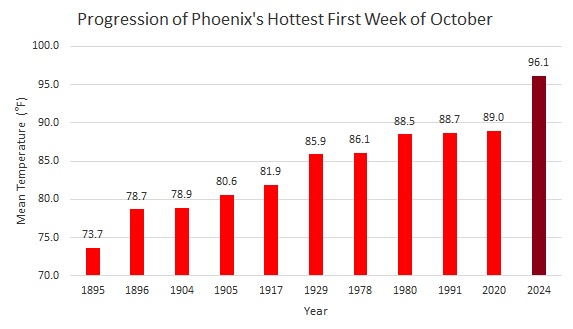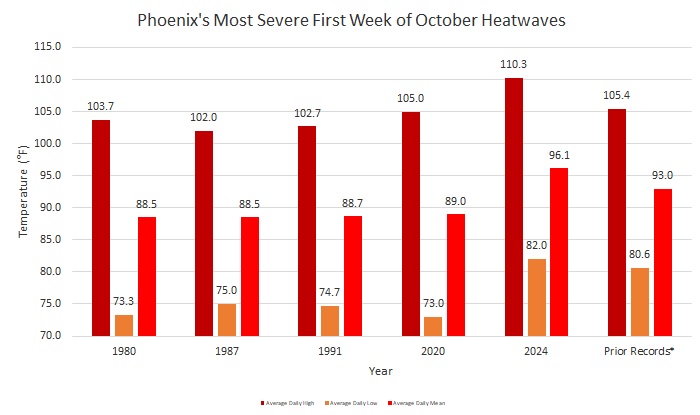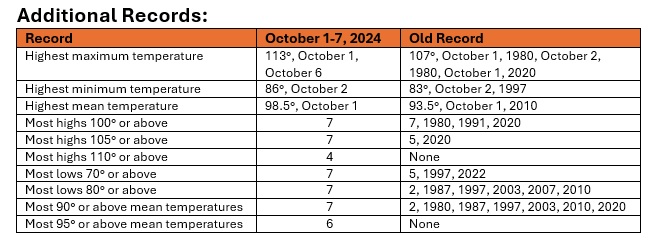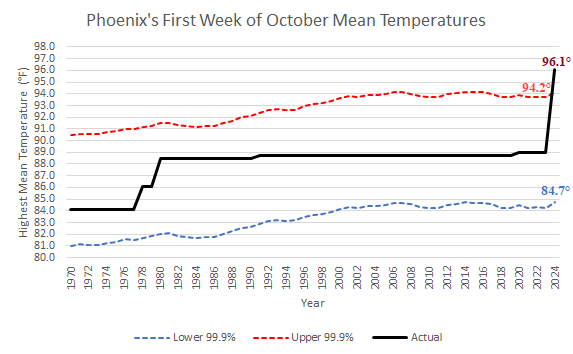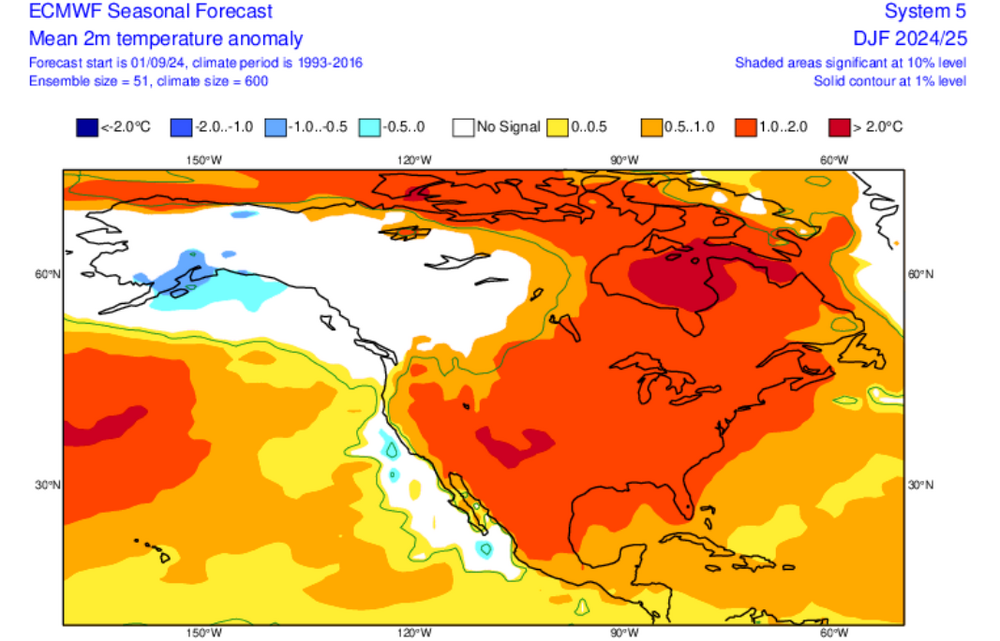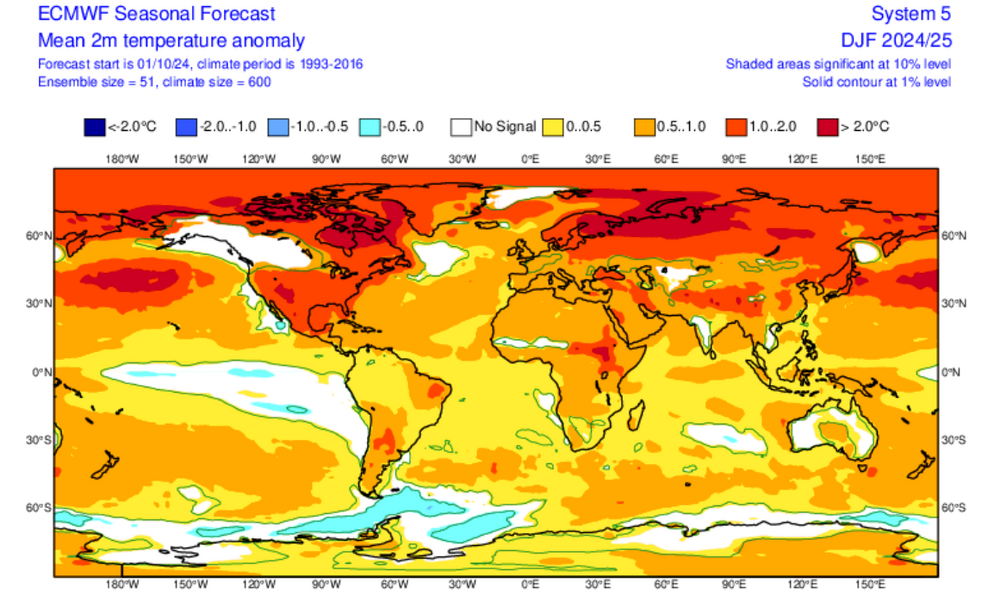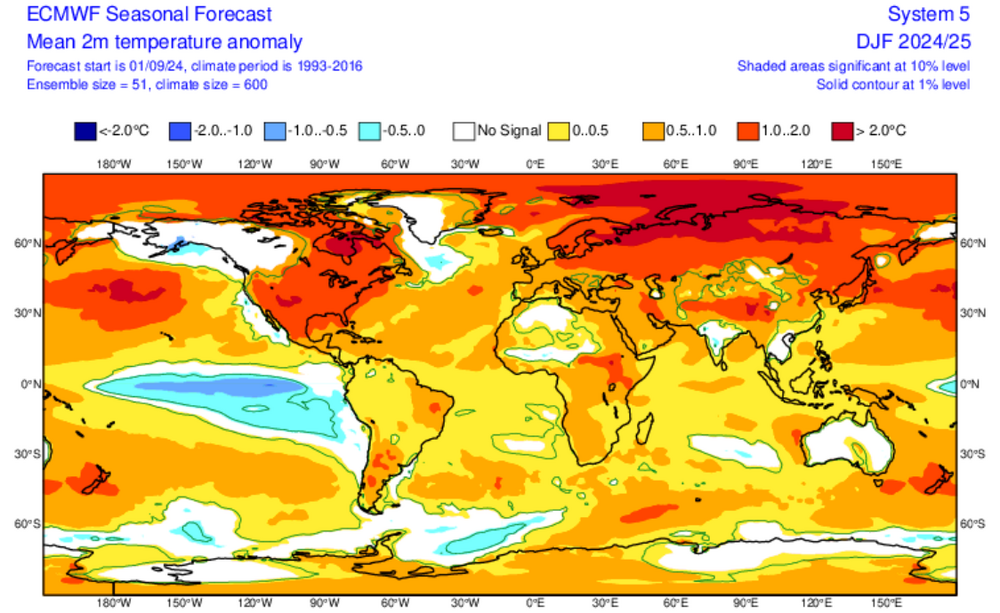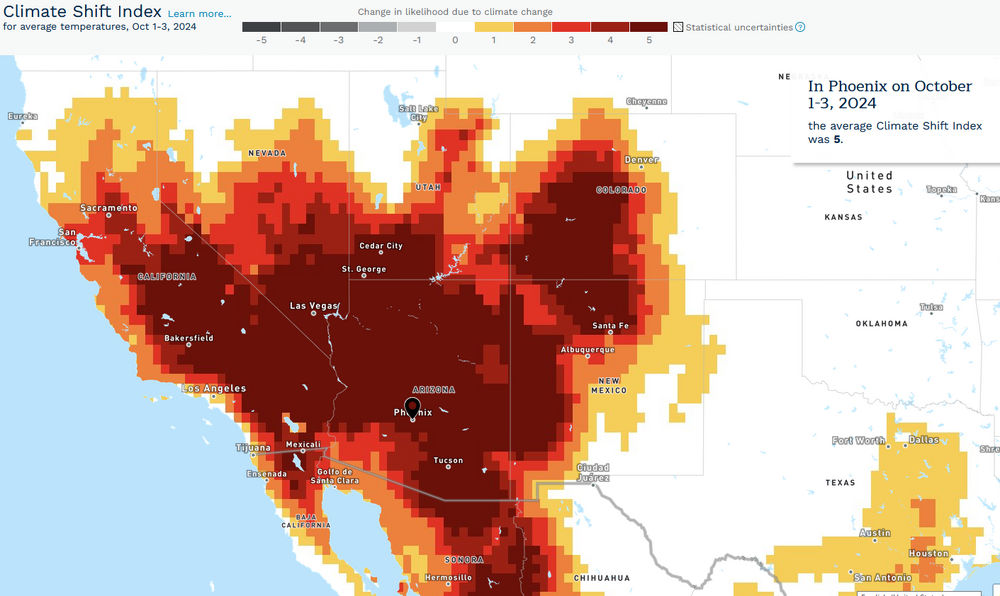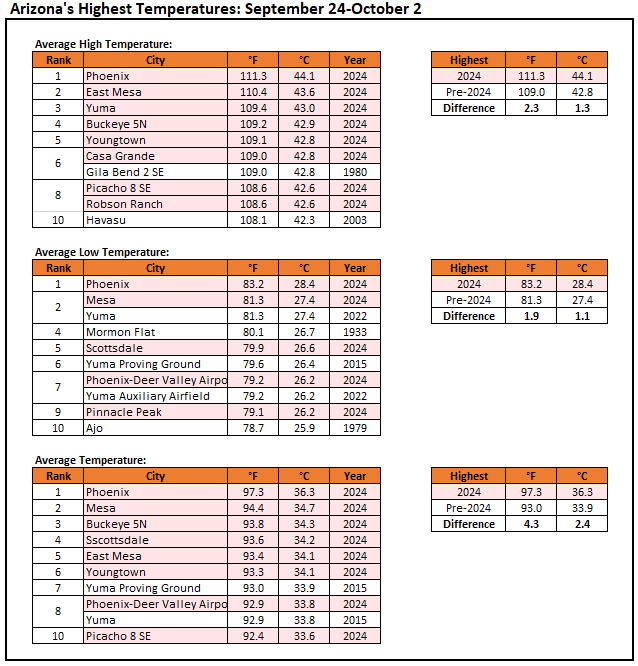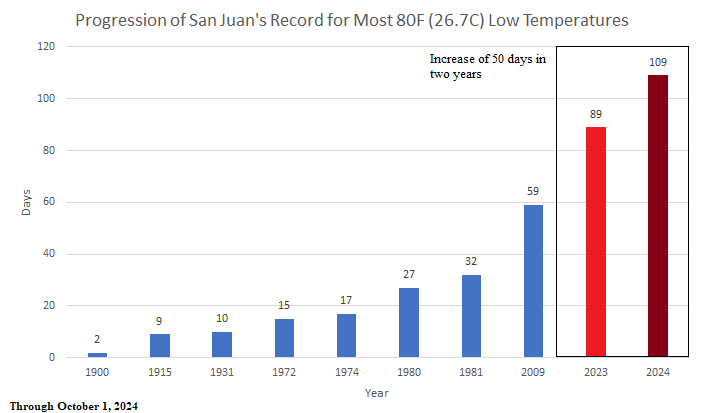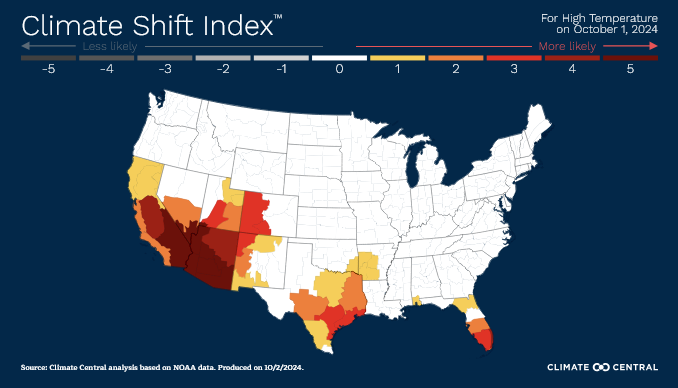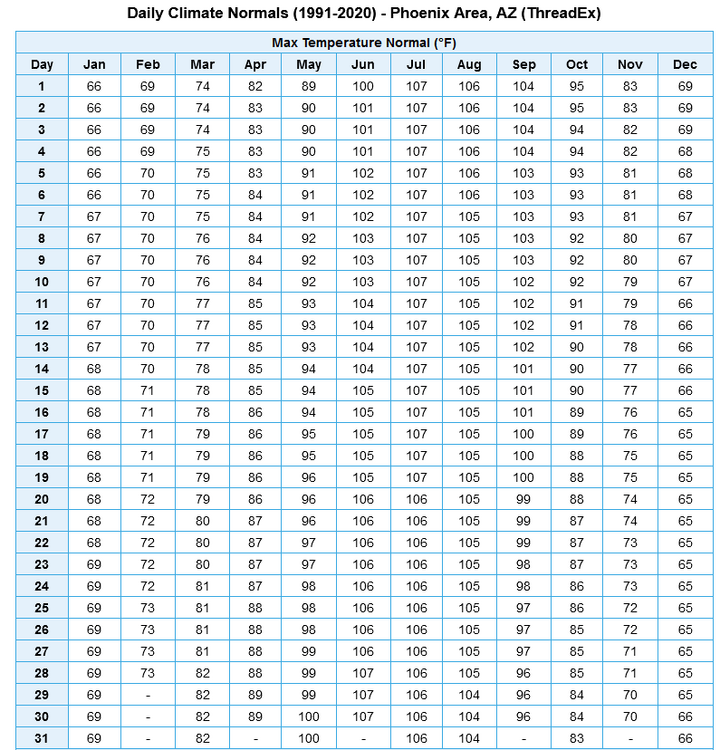-
Posts
22,901 -
Joined
Content Type
Profiles
Blogs
Forums
American Weather
Media Demo
Store
Gallery
Everything posted by donsutherland1
-
Here is how Arizona's record book was rewritten during the 14-day September 24-October 7, 2024 period:
-
October 1-7, 2024 saw Phoenix demolish the record for its hottest first week of October on record. No prior October heatwave even begins to compare. Even a synthetic heatwave constructed of all October 1-7 pre-2024 record high maximum and minimum temperatures was smashed. Climate change played a leading role in driving the unprecedented heat, which included a 14-consecutive day stretch of record tying and record breaking high temperatures (September 24-October 7). According to Climate Central's Climate Shift Index, the heat in Phoenix and surrounding areas (including rural areas not impacted by the Urban Heat Island Effect) was made at least five times as likely due to climate change. Select Charts: The October 1-7, 2024 96.1° 7-day mean temperature was so extreme that it falls outside of what would statistically be expected using a 99.9% confidence interval based on 30-year moving average October 1-7 mean temperatures. The incredible late-season heat was widespread in the Southwest. Numerous records were broken, some by very large margins.
-
The region will see its coolest air so far this season this week. Tomorrow will be cooler and then a reinforcing shot of even chillier air will arrive on Wednesday. New York City could see its first temperature below 50° since May 13th on Thursday or Friday. On Wednesday evening, Hurricane Milton will make landfall on Florida's west coast. The storm, which grew into an extreme Category 5 hurricane with an 897 mb central pressure and maximum sustained winds of 180 mph, will likely make landfall as a Category 3 and perhaps Category 4 hurricane. It will bring a devastating storm surge inland. There remains a risk that the heavily populated Tampa ara could face some of the hurricane's worst impacts. The later guidance will lead to a more precise picture. In the Southwest and parts of California, near record and record heat continued. Phoenix registered its fourth 110° high temperature this month. San Jose experienced its longest stretch of 95° or above temperatures on record. Death Valley, Palm Springs, and Phoenix all exceeded the national record for average high temperature during the 14-day September 24-October 7 period. The extreme heat will fade over the next few days. The NAO fell to a preliminary -2.751 on September 24th (all-time September record: -2.371, September 12, 1971). That was the 9th lowest value on record. La Niña winters following September cases where the NAO fell to -1.900 or below featured a predominantly positive NAO. The most recent such winters were 2016-2017 and 2022-2023. The mean temperatures for those winters in New York City were 39.3° and 41.0° respectively. The 1991-2020 normal value is 36.2°. A warmer outcome is favored by the September run of the C3S multi-model forecast for Winter 2024-2025. Weekly ENSO data remains unavailable due to the dirsuptive impact Hurricane Helene's floods had on NCEI in Asheville. The ENSO Region 1+2 anomaly was +0.2°C and the Region 3.4 anomaly was -0.5°C for the week centered around September 18. For the past six weeks, the ENSO Region 1+2 anomaly has averaged -0.20°C and the ENSO Region 3.4 anomaly has averaged -0.18°C. Neutral ENSO conditions will likely evolve into a La Niña event during the fall. The SOI was +15.79 today. The preliminary Arctic Oscillation (AO) was -2.445 today. Based on sensitivity analysis applied to the latest guidance, there is an implied 58% probability that New York City will have a warmer than normal October (1991-2020 normal). October will likely finish with a mean temperature near 58.5° (0.6° above normal).
- 1,188 replies
-

Occasional Thoughts on Climate Change
donsutherland1 replied to donsutherland1's topic in Climate Change
Hurricane Milton is the latest tropical cyclone to undergo rapid intensification (RI). It has intensified at among the fastest rates on record. In response, as happened with Hurricane Helene, the climate change denial community will all but certainly try to dismiss the climate change link through a deluge of logical fallacies and disinformation. Climate denial arguments could suggest or imply that the occurrence of past hurricanes precludes a climate link, past rapid intensification cases preclude a climate link, a direct hit in the Tampa Bay area in 1848 means that climate change could not have contributed to a similar outcome, tropical cyclones are synoptic events therefore climate change or CO2 isn't involved, or that there is no trend in RI cases (using "cherry-picked" timeframes), etc. One should ignore the Social Media noise toward that end and obtain their information from credible sources. Those making the arguments have motivated bias, are uninformed, are unable to synthesize multiple data points to reach informed judgments (how climate change can impact tropical cyclones through marine heatwaves, greater atmospheric moisture, etc). Findings: As long-term variations in RI are potentially influenced by large-scale circulation and global ocean conditions, the effects of internal climate variability and global ocean warming were investigated. The internal climate variability was assessed using climate indices such as El Niño–Southern Oscillation (ENSO) and Pacific Decadal Oscillation (PDO), while the effects of global warming were estimated using the trend of global mean sea surface temperature (SST) between 60 °S and 75 °N. The impacts of these metrics were eliminated by linearly regressing the time series of the RI onto the climate indices. Marginal differences were found when the Niño3 index was removed, and the amplitude of RI landward variation... maintained at 0.4 ± 0.2/decade/1000 km. This indicates that the impacts of ENSO on these long-term landward variations are negligible, although it may have a substantial role in inter-annual variability50; hence, further exploration is required. Meanwhile, the PDO or global mean SST alone moderately influenced RI. With the removal of their impacts, the landward variation rates decreased slightly to 0.3/decade/000 km for PDO and 0.2/decade/1000 km for SST... However, it should be mentioned that with the impacts of global SST removed, the increasing rate of RI events declined to ~0/decade per decade, particularly in regions that were beyond 600 km from the coast. This suggests that global warming is a key driver of increases in RI events... https://www.nature.com/articles/s41467-023-40605-2 ...our conclusions indicate that anthropogenically-forced climate change has already contributed to the observed, detectable increase in the proportion of rapidly intensifying hurricanes... https://www.nature.com/articles/s41467-022-34321-6#change-history TCs are amongst costliest and most dangerous natural hazards to impact the U.S., and the hazard they present has grown as storms have become more extreme due to anthropogenic warming. The rapid intensification of TCs in a warmer climate is particularly concerning, given that such events can be difficult to forecast and predict, leading to potentially escalated damages as well as difficulties when communicating the approaching hazard to coastal residents who may be in the TC’s path... These peak TC intensification rates have increased alongside anthropogenically-driven increases in SSTs, which have been rising at an increased rate in recent decades. Sufficiently warm SSTs serve as a vital energy source for intensifying TCs, and simultaneous increases in both extreme SSTs and maximum TC intensification rates suggests that human-caused warming has already had a measurable impact on the speed with which TCs strengthen. https://www.nature.com/articles/s41598-023-42669-y -
Tomorrow will be variably cloudy with perhaps some morning showers or even a thundershower as a strong cold front crosses the region. Following the frontal passage, the region will see its coolest air so far this season. New York City could see its first temperature below 50° since May 13th after midweek. During the middle of the week, Hurricane Milton will make landfall on Florida's west coast. The storm will likely make landfall as a Category 3 and perhaps Category 4 hurricane. It will bring a devastating storm surge inland. There remains a risk that Tampa could face some of the hurricane's worst impacts even as the guidance has shifted somewhat southward. The later guidance will lead to a more precise picture. In the Southwest and parts of California, near record and record heat continued. Phoenix reached 113°, which smashed the daily record by 8° and tied the monthly record set on October 1st. Since September 25th, Phoenix has had 6 days with highs of 113° or above. In its full-year climate record that goes back to 1896, 98 years (76% of the record) had fewer than 6 such days. The most recent such year was 2014 (3 days). The region has never seen a late-season heatwave like the current one. The extreme heat will fade toward midweek. The NAO fell to a preliminary -2.751 on September 24th (all-time September record: -2.371, September 12, 1971). That was the 9th lowest value on record. La Niña winters following September cases where the NAO fell to -1.900 or below featured a predominantly positive NAO. The most recent such winters were 2016-2017 and 2022-2023. The mean temperatures for those winters in New York City were 39.3° and 41.0° respectively. The 1991-2020 normal value is 36.2°. A warmer outcome is favored by the September run of the C3S multi-model forecast for Winter 2024-2025. The ENSO Region 1+2 anomaly was +0.2°C and the Region 3.4 anomaly was -0.5°C for the week centered around September 18. For the past six weeks, the ENSO Region 1+2 anomaly has averaged -0.20°C and the ENSO Region 3.4 anomaly has averaged -0.18°C. Neutral ENSO conditions will likely evolve into a La Niña event during the fall. The SOI was +10.31 today. The preliminary Arctic Oscillation (AO) was -1.970 today.
- 1,188 replies
-
Yes. I used the whole January-March period.
-
Since 1950, there were 12 La Niña events that had warmer than normal Decembers in the northern Mid-Atlantic region. Two were colder than normal with near normal to above normal snowfall. Two were also warmer than normal with above normal snowfall. Six were warmer to much warmer than normal with below to much below normal snowfall. January-March 2009 and January-March 1974 had the best combination of cold and snow following a warm December.
-
It will turn somewhat cooler tomorrow. Monday could see some showers as a strong cold front crosses the region. In its wake, the region will see its coolest air so far this season. New York City could see its first temperature below 50° since May 13th during the second half of next week. During the middle of the week, what will likely become major Hurricane Milton will likely make landfall on Florida's west coast. The storm will bring a devastating storm surge inland. There is a risk that Tampa could face some of the hurricane's worst impacts, but later guidance will lead to a more precise picture. In the Southwest and parts of California, near record and record heat continued. Phoenix reached 111°. Palm Springs reached 115°. That was the highest temperature on record so late in the season in the United States. The extreme heat will persist into early next week before it fades. The NAO fell to a preliminary -2.751 on September 24th (all-time September record: -2.371, September 12, 1971). That was the 9th lowest value on record. La Niña winters following September cases where the NAO fell to -1.900 or below featured a predominantly positive NAO. The most recent such winters were 2016-2017 and 2022-2023. The mean temperatures for those winters in New York City were 39.3° and 41.0° respectively. The 1991-2020 normal value is 36.2°. A warmer outcome is favored by the September run of the C3S multi-model forecast for Winter 2024-2025. The ENSO Region 1+2 anomaly was +0.2°C and the Region 3.4 anomaly was -0.5°C for the week centered around September 18. For the past six weeks, the ENSO Region 1+2 anomaly has averaged -0.20°C and the ENSO Region 3.4 anomaly has averaged -0.18°C. Neutral ENSO conditions will likely evolve into a La Niña event during the fall. The SOI was +2.19 today. The preliminary Arctic Oscillation (AO) was -1.569 today.
- 1,188 replies
-
When it gets closer to the season, I'll post month-by-month estimates (if I recall correctly, the skill related to the 3-month average is better than that for month-by-month forecasts from this timeframe). The key takeaway right now is that the Euro seasonal is warm, but not as warm as the last two winters. All things being equal, there should be some better opportunities for snowfall than one has seen in parts of the East during the past two winters. I still think the Great Lakes region will have normal to somewhat above normal snowfall. For those who are interested, February is forecast to be only slightly above normal in the Mid-Atlantic Region (southern Great Lakes Region) and near normal in New England (much of the Great Lakes Region).
-
-
Tomorrow will be warm for the season. A shower is possible. The temperature will top out in the lower and middle 70s. It will turn somewhat cooler on Sunday. Monday could see some showers as a strong cold front crosses the region. In its wake, the region will see its coolest air so far this season. In the Southwest and parts of California, near record and record heat continued. As of 2 pm MST, Tucson had reached 106°, which broke that city's October record of 105° that had been set on October 1. Phoenix had reached 108°, surpassing the old October monthly record for the fourth consecutive day. The extreme heat will persist into early next week. The NAO fell to a preliminary -2.751 on September 24th (all-time September record: -2.371, September 12, 1971). That was the 9th lowest value on record. La Niña winters following September cases where the NAO fell to -1.900 or below featured a predominantly positive NAO. The most recent such winters were 2016-2017 and 2022-2023. The mean temperatures for those winters in New York City were 39.3° and 41.0° respectively. The 1991-2020 normal value is 36.2°. A warmer outcome is favored by the September run of the C3S multi-model forecast for Winter 2024-2025. The ENSO Region 1+2 anomaly was +0.2°C and the Region 3.4 anomaly was -0.5°C for the week centered around September 18. For the past six weeks, the ENSO Region 1+2 anomaly has averaged -0.20°C and the ENSO Region 3.4 anomaly has averaged -0.18°C. Neutral ENSO conditions will likely evolve into a La Niña event during the fall. The SOI was -5.61 today. The preliminary Arctic Oscillation (AO) was -1.421 today.
- 1,188 replies
-
The heat so far in October has been made at least 5 times as likely by climate change in the Phoenix area and a large swath of the southwestern United States.
-

Occasional Thoughts on Climate Change
donsutherland1 replied to donsutherland1's topic in Climate Change
I'm actually not surprised by this development. Daily/monthly temperature extremes recorded in various parts of the world exceed the amount of overall warming that has occurred. It seems that on shorter timeframes, there are factors or combinations of variables that amplify what one would expect from the warming and, in this case, increase in atmospheric water vapor. There has been periodic discussion of a non-linear response in extremes. This is probably one area where more research is needed. -
I agree. A wide range of data products has been disrupted.
-
It will likely turn somewhat milder for tomorrow and Saturday. Temperatures will top out generally in the lower and perhaps middle 70s. Cooler air could arrive Sunday and then again early next week with the coolest air so far this season moving into the region. In the Southwest and parts of California, near record and record heat continued. Numerous locations including Fresno, Hanford, and Stockton tied or broke October monthly records. Phoenix reached 109°. Needles reached 110° for the 80th time this year, breaking the record of 79 days from 1924. The extreme heat will persist into the weekend. The NAO fell to a preliminary -2.751 on September 24th (all-time September record: -2.371, September 12, 1971). That was the 9th lowest value on record. La Niña winters following September cases where the NAO fell to -1.900 or below featured a predominantly positive NAO. The most recent such winters were 2016-2017 and 2022-2023. The mean temperatures for those winters in New York City were 39.3° and 41.0° respectively. The 1991-2020 normal value is 36.2°. A warmer outcome is favored by the September run of the C3S multi-model forecast for Winter 2024-2025. The ENSO Region 1+2 anomaly was +0.2°C and the Region 3.4 anomaly was -0.5°C for the week centered around September 18. For the past six weeks, the ENSO Region 1+2 anomaly has averaged -0.20°C and the ENSO Region 3.4 anomaly has averaged -0.18°C. Neutral ENSO conditions will likely evolve into a La Niña event during the fall. The SOI was -5.61 today. The preliminary Arctic Oscillation (AO) was -1.078 today.
- 1,188 replies
-
- 1
-

-
That's probably because of Helene's impact on NCEI's Asheville center.
-
The ongoing historic late-season heatwave in Arizona is unprecedented in the State's climate record. The 9-day period has set state records for highest average high temperature, average low temperature, and average temperature for the September 24-October 2 period. All of those marks are at least 1°C (1.8°F) above their prior marks.
-
Tomorrow will be variably cloudy with temperatures again reaching the upper 60s and lower 70s. It will likely turn somewhat milder for Friday and Saturday. Cooler air could arrive Sunday with the coolest air so far this season arriving early next week. In the Southwest and parts of California, near record and record heat continued. Through 3:50 pm MST, Phoenix had reached a daily record 108°. That marked the second consecutive day that the temperature surpassed the pre-2024 October monthly record. The extreme heat will persist into the weekend. The NAO fell to a preliminary -2.751 on September 24th (all-time September record: -2.371, September 12, 1971). That was the 9th lowest value on record. La Niña winters following September cases where the NAO fell to -1.900 or below featured a predominantly positive NAO. The most recent such winters were 2016-2017 and 2022-2023. The mean temperatures for those winters in New York City were 39.3° and 41.0° respectively. The 1991-2020 normal value is 36.2°. A warmer outcome is favored by the September run of the C3S multi-model forecast for Winter 2024-2025. The ENSO Region 1+2 anomaly was +0.2°C and the Region 3.4 anomaly was -0.5°C for the week centered around September 18. For the past six weeks, the ENSO Region 1+2 anomaly has averaged -0.20°C and the ENSO Region 3.4 anomaly has averaged -0.18°C. Neutral ENSO conditions will likely evolve into a La Niña event during the fall. The SOI was 0.00 today. The preliminary Arctic Oscillation (AO) was -0.697 today.
- 1,188 replies
-

Occasional Thoughts on Climate Change
donsutherland1 replied to donsutherland1's topic in Climate Change
While Phoenix's unprecedented late-season heatwave is making global headlines, as it should, San Juan has destroyed its record for most 80° lows for the second consecutive year. -

Occasional Thoughts on Climate Change
donsutherland1 replied to donsutherland1's topic in Climate Change
One is already witnessing the impact of climate change (warming oceans) on precipitation from atmospheric rivers in California. Precipitation amounts and intensity will continue to increase in a warming climate. https://www.science.org/doi/full/10.1126/sciadv.aba1323 -

Occasional Thoughts on Climate Change
donsutherland1 replied to donsutherland1's topic in Climate Change
Phoenix is in the midst of an unprecedented late-season heatwave that saw the city reach a September (and August-tying) monthly record of 117° on September 28th and an October monthly record of 113° (old monthly mark: 107°) on October 1st. The seven-day September 25-October 1 period has had an average high temperature of 112.3° (old September 25-October 1 mark: 104.9°). That period has also seen six 110° or above high temperatures and five 113° or above temperatures. Prior to this heatwave, Phoenix had never seen a 110° or above temperature after September 19th and a 113° or above temperature after September 10th. Records go back to August 1895. The extraordinary heat, which has also seen Indio, CA and Palm Springs tie the national October record of 117° has brought out a torrent of climate change deniers seeking to dismiss what is taking place. Each has revealed climate illiteracy in their wide-ranging efforts to dismiss what is taking place. Key Points: 1. The discussion has concerned Phoenix's climate record, which goes back to August 1895. References to 1367 and regional temperatures millions of years ago before the city even existed are irrelevant. Globally, the paleoclimate record shows that 2023-level temperatures were the warmest in 125,000 years. Phoenix was not experiencing the kind of heatwaves like the current one during colder global periods within its climate record. It is all but certain statistically that had instruments existed and temperatures been recorded in 1367, Phoenix would not have seen a late-season heatwave anywhere close to the current one. 2. Urban Heat Island (UHI) is real. However, its impacts are greatest at night. Moreover, even small towns e.g., Tacna, AZ (2024 population: 511) have been experiencing an unprecedented late-season heatwave. Moreover, USCRN sites in Arizona have also been experiencing notable warming. UHI cannot solely or largely explain the Phoenix's warming, much less its current heatwave. Rapid attribution by Climate Central revealed that, for example, yesterday's high temperatures in the Phoenix area were made at least 5 times as likely as due to climate change. A World Weather Attribution study of concurrent European, Asian, and Mexico/U.S. heatwaves (including in the Phoenix area) during July 2023 revealed that the heatwave was "virtually impossible" without climate change and about 2°C (3.6°F) warmer due to climate change. The individual suggesting that UHI fully explains Phoenix's heat has been fact checked for posting misleading or incorrect information three times by AFP. 3. Although the desert is hot, there are climate records. The current heatwave is far above what is normal for this time of year. In Phoenix, the October 1 high temperature was 18° above the normal value for the date. 4. Bastardi has already been fact checked by AFP on his claims regarding volcanoes. Human emissions are driving rising atmospheric CO2. Rising atmospheric greenhouse gases, including CO2, are driving the ongoing warming. In its Sixth Assessment Report, the IPCC explained: Human activities, principally through emissions of greenhouse gases, have unequivocally caused global warming, with global surface temperature reaching 1.1°C above 1850-1900 in 2011-2020. Global greenhouse gas emissions have continued to increase, with unequal historical and ongoing contributions arising from unsustainable energy use, land use and land-use change, lifestyles and patterns of consumption and production across regions, between and within countries, and among individuals (high confidence). 5. Numerous drivers impact climate. A recent study covering 485 million years revealed, "CO2 is the dominant control on Phanerozoic climate." Conclusion: Phoenix is experiencing an unprecedented late-season heatwave. Climate change has increased the likelihood and intensity of such a heatwave. Those seeking information should look to credible sources of weather and climate information, not Social Media noisemakers who have little or no understanding of Phoenix's climate or climate change or who seek to mislead on climate/climate change.


